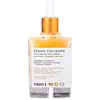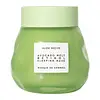What's inside
What's inside
 Key Ingredients
Key Ingredients

 Benefits
Benefits

 Concerns
Concerns

 Ingredients Side-by-side
Ingredients Side-by-side

Aloe Barbadensis Leaf Juice
Skin ConditioningWater
Skin ConditioningCaprylic/Capric Triglyceride
MaskingPhenoxyethanol
PreservativeGlycerin
HumectantHamamelis Virginiana Water
AstringentPhospholipids
Skin ConditioningRetinol
Skin ConditioningCollagen
MoisturisingMelia Azadirachta Leaf Extract
Skin ConditioningMelia Azadirachta Flower Extract
Skin ConditioningCurcuma Longa Root Extract
MaskingOcimum Sanctum Leaf Extract
Skin ConditioningOcimum Basilicum Flower/Leaf Extract
TonicCorallina Officinalis Extract
Skin ConditioningAscorbic Acid
AntioxidantAlcohol
AntimicrobialCarbomer
Emulsion StabilisingTriethanolamine
BufferingTetrasodium Glutamate Diacetate
Aloe Barbadensis Leaf Juice, Water, Caprylic/Capric Triglyceride, Phenoxyethanol, Glycerin, Hamamelis Virginiana Water, Phospholipids, Retinol, Collagen, Melia Azadirachta Leaf Extract, Melia Azadirachta Flower Extract, Curcuma Longa Root Extract, Ocimum Sanctum Leaf Extract, Ocimum Basilicum Flower/Leaf Extract, Corallina Officinalis Extract, Ascorbic Acid, Alcohol, Carbomer, Triethanolamine, Tetrasodium Glutamate Diacetate
Water
Skin ConditioningPropanediol
SolventGlycerin
HumectantCetearyl Alcohol
EmollientGlyceryl Stearate
EmollientC9-12 Alkane
SolventCaprylic/Capric Triglyceride
MaskingKaolin
AbrasivePersea Gratissima Oil
Skin ConditioningPolyisobutene
Sodium Lauroyl Glutamate
Stearic Acid
CleansingC13-15 Alkane
SolventPlatonia Insignis Seed Butter
EmollientPersea Gratissima Fruit Extract
EmollientHyaluronic Acid
HumectantSodium Hyaluronate
HumectantSqualane
EmollientChamomilla Recutita Flower Extract
MaskingCamellia Sinensis Leaf Extract
AntimicrobialSaccharide Isomerate
HumectantHexylresorcinol
AntimicrobialZingiber Officinale Root Extract
MaskingOryza Sativa Extract
AbsorbentTocopheryl Acetate
AntioxidantGluconolactone
Skin ConditioningAloe Barbadensis Leaf Juice
Skin ConditioningMalachite Extract
AntioxidantEthylhexyl Palmitate
EmollientButylene Glycol
HumectantSodium Chloride
MaskingSodium Hydroxypropylsulfonate Laurylglucoside Crosspolymer
CleansingMaltodextrin
AbsorbentHydrated Silica
AbrasiveCurcumin
AntioxidantEthylhexylglycerin
Skin ConditioningPPG-3 Benzyl Ether Myristate
EmollientMaltooligosyl Glucoside
Skin ConditioningHydrogenated Starch Hydrolysate
HumectantRetinol
Skin ConditioningSpirulina Maxima Extract
SmoothingSodium Phosphate
BufferingPei-10
Citric Acid
BufferingSodium Citrate
BufferingSodium Dilauramidoglutamide Lysine
HumectantPotassium Phosphate
BufferingPotassium Chloride
Silica Dimethyl Silylate
EmollientArginine
MaskingSodium Hydroxide
BufferingCaprylyl Glycol
EmollientTocopherol
AntioxidantRosmarinus Officinalis Leaf Extract
AntimicrobialLavandula Angustifolia Flower/Leaf/Stem Extract
MaskingHexylene Glycol
EmulsifyingAcrylates/C10-30 Alkyl Acrylate Crosspolymer
Emulsion StabilisingPotassium Sorbate
PreservativeCarthamus Tinctorius Seed Extract
Skin ConditioningAroma
Pvp
Emulsion StabilisingSodium Benzoate
MaskingPhenoxyethanol
PreservativeParfum
MaskingWater, Propanediol, Glycerin, Cetearyl Alcohol, Glyceryl Stearate, C9-12 Alkane, Caprylic/Capric Triglyceride, Kaolin, Persea Gratissima Oil, Polyisobutene, Sodium Lauroyl Glutamate, Stearic Acid, C13-15 Alkane, Platonia Insignis Seed Butter, Persea Gratissima Fruit Extract, Hyaluronic Acid, Sodium Hyaluronate, Squalane, Chamomilla Recutita Flower Extract, Camellia Sinensis Leaf Extract, Saccharide Isomerate, Hexylresorcinol, Zingiber Officinale Root Extract, Oryza Sativa Extract, Tocopheryl Acetate, Gluconolactone, Aloe Barbadensis Leaf Juice, Malachite Extract, Ethylhexyl Palmitate, Butylene Glycol, Sodium Chloride, Sodium Hydroxypropylsulfonate Laurylglucoside Crosspolymer, Maltodextrin, Hydrated Silica, Curcumin, Ethylhexylglycerin, PPG-3 Benzyl Ether Myristate, Maltooligosyl Glucoside, Hydrogenated Starch Hydrolysate, Retinol, Spirulina Maxima Extract, Sodium Phosphate, Pei-10, Citric Acid, Sodium Citrate, Sodium Dilauramidoglutamide Lysine, Potassium Phosphate, Potassium Chloride, Silica Dimethyl Silylate, Arginine, Sodium Hydroxide, Caprylyl Glycol, Tocopherol, Rosmarinus Officinalis Leaf Extract, Lavandula Angustifolia Flower/Leaf/Stem Extract, Hexylene Glycol, Acrylates/C10-30 Alkyl Acrylate Crosspolymer, Potassium Sorbate, Carthamus Tinctorius Seed Extract, Aroma, Pvp, Sodium Benzoate, Phenoxyethanol, Parfum
Ingredients Explained
These ingredients are found in both products.
Ingredients higher up in an ingredient list are typically present in a larger amount.
Aloe Barbadensis Leaf Juice comes from leaves of the aloe plant. Aloe Barbadensis Leaf Juice is best known for helping to soothe sunburns. It is also anti-inflammatory, moisturizing, antiseptic, and can help heal wounds.
Aloe is packed with good stuff including Vitamins A, C, and E. These vitamins are antioxidants, which help fight free-radicals and the damage they may cause. Free-radicals are molecules that may damage your skin cells, such as pollution.
Aloe Barbadensis Leaf Juice also contains sugars. These sugars come in the form of monosaccharides and polysaccharides, folic acid, and choline. These sugars are able to help bind moisture to skin.
It also contains minerals such as calcium, 12 anthraquinones, fatty acids, amino acids, and Vitamin B12.
Learn more about Aloe Barbadensis Leaf JuiceThis ingredient is an emollient, solvent, and texture enhancer. It is considered a skin-softener by helping the skin prevent moisture loss.
It helps thicken a product's formula and makes it easier to spread by dissolving clumping compounds.
Caprylic Triglyceride is made by combining glycerin with coconut oil, forming a clear liquid.
While there is an assumption Caprylic Triglyceride can clog pores due to it being derived from coconut oil, there is no research supporting this.
Learn more about Caprylic/Capric TriglycerideGlycerin is already naturally found in your skin. It helps moisturize and protect your skin.
A study from 2016 found glycerin to be more effective as a humectant than AHAs and hyaluronic acid.
As a humectant, it helps the skin stay hydrated by pulling moisture to your skin. The low molecular weight of glycerin allows it to pull moisture into the deeper layers of your skin.
Hydrated skin improves your skin barrier; Your skin barrier helps protect against irritants and bacteria.
Glycerin has also been found to have antimicrobial and antiviral properties. Due to these properties, glycerin is often used in wound and burn treatments.
In cosmetics, glycerin is usually derived from plants such as soybean or palm. However, it can also be sourced from animals, such as tallow or animal fat.
This ingredient is organic, colorless, odorless, and non-toxic.
Glycerin is the name for this ingredient in American English. British English uses Glycerol/Glycerine.
Learn more about GlycerinPhenoxyethanol is a preservative that has germicide, antimicrobial, and aromatic properties. Studies show that phenoxyethanol can prevent microbial growth. By itself, it has a scent that is similar to that of a rose.
It's often used in formulations along with Caprylyl Glycol to preserve the shelf life of products.
Retinol is a gold-standard ingredient for anti-aging. It is a form of Vitamin A and belongs to the class of retinoids that also includes tretinoin.
Why is retinol famous?
It has the most scientific studies backing up its skin benefits out of all the non-prescription ingredients.
Retinol is proven to:
This is why retinol is effective at removing wrinkles, fading dark spots, treating acne, and reducing the appearance of pores.
Studies show retinol is less effective when exposed to UV. Be sure to look for appropriate packaging to keep your retinol potent (similar to Vitamin C).
Using retinol or any retinoids will increase sun-sensitivity in the first few months. Though studies show retinoids increase your skin's natural SPF with continuous use, it is best to always wear sunscreen and sun-protection.
We recommend speaking with a medical professional about using this ingredient during pregnancy.
Retinol may cause irritation in some people, so be sure to patch test. Experts recommend 'ramping up' retinol use: start using this ingredient once a week and work up to using it daily.
Read about Tretinoin
Learn more about RetinolWater. It's the most common cosmetic ingredient of all. You'll usually see it at the top of ingredient lists, meaning that it makes up the largest part of the product.
So why is it so popular? Water most often acts as a solvent - this means that it helps dissolve other ingredients into the formulation.
You'll also recognize water as that liquid we all need to stay alive. If you see this, drink a glass of water. Stay hydrated!
Learn more about Water